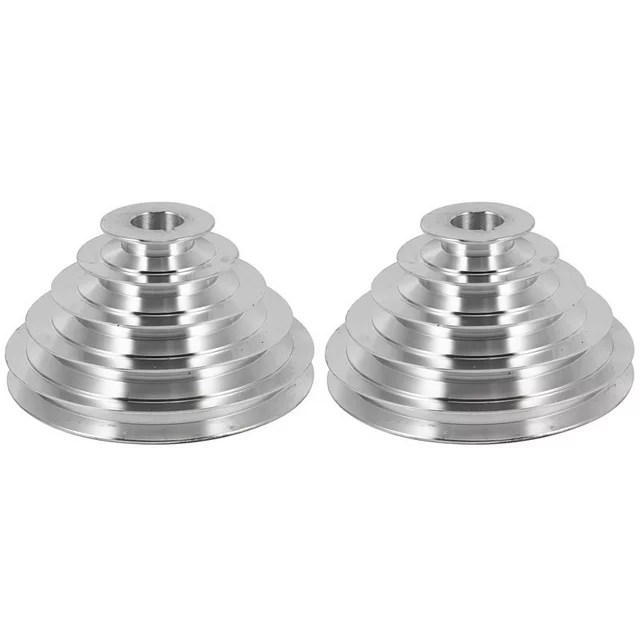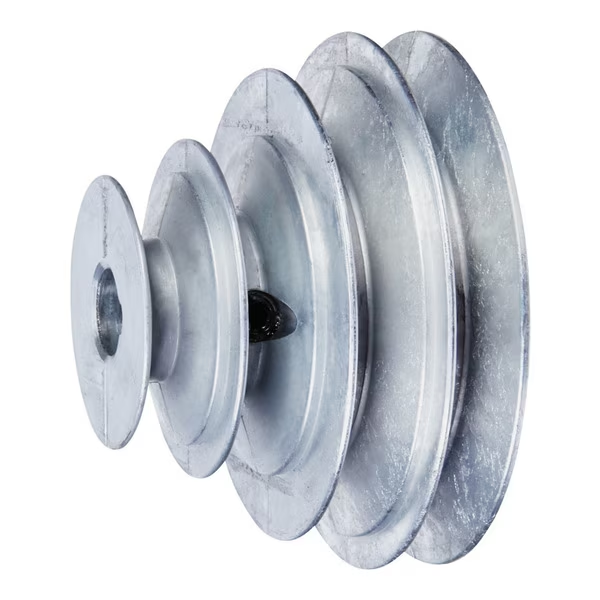Product Description
Made in China Machinery Spare Part CNC Cutting Stamping Machining Power Transmission Part Bush Pulley
| We Are Professional Metal Processing Factory With Modern Automation Equipment, Specialized in Precision Machining part /Turning part /Welding part /Precision Fixture.Send Us RFQ Now, We will Feedback You Quotation Within 24 Hours. |
Product Description
| Equipment |
| 3-axis, 4-axis and full 5-axis processing equipment, CNC lathe, centering machine, turning and milling compound, wire cutting, EDM, grinding, etc |
| Processing |
| CNC machining, CNC Turning, CNC Milling, Welding, Laser Cutting, Bending, Spinning, Wire Cutting, Stamping, Electric Discharge Machining (EDM), Injection Molding |
| Materials |
| Aluminum:2000 series, 6000 series, 7075, 5052, etc. |
| Stainless steel: SUS303, SUS304, SS316, SS316L, 17-4PH, etc. |
| Steel:1214L/1215/1045/4140/SCM440/40CrMo, etc. |
| Brass:260, C360, H59, H60, H62, H63, H65, H68, H70, Bronze, Copper |
| Titanium:Grade F1-F5 |
| Plastic:Acetal/POM/PA/Nylon/PC/PMMA/PVC/PU/Acrylic/ABS/PTFE/PEEK etc. |
| Tolerance |
| +/-0.002~+/-0.005mm |
| Our Advantages |
| 1)24 hours online service & Quickly Quote/Delivery. 2)100% QC quality inspection before delivery, and can provide quality inspection form. 3)10+ years of experience in the CNC machining area and have a senior design team to offer perfect modification suggestions |
| Quality Assurance |
| 100% Inspect Before Shipment, ISO9001:2015, ISO13485:2016, SGS, RoHs, TUV |
| Serface Treatment |
| Aluminum parts:Clear Anodized, Color Anodized, Sandblast Anodized, Chemical Film, Brushing, Polishing Stainless Steel parts:Polishing, Passivating, Sandblasting, Laser engraving, Electrophoresis black, Oxide black Steel parts:Zinc Plating, Oxide black, Nickel Plating, Chrome Plating, Carburized, Heat treatment Brass parts:Nickel Plating, chrome plating, Electrophoresis black, Oxide black, Powder coated |
Click Here Get Free Quotation
Machining Workshop
| Nonstander Gears Display |
| Strictly on Quality Contoul, 100% Inspect Before Shipment |
Click Here Get More Information
Packging And Delivery
Application Industry
| Areospace |
| Cylinder Heads, Turbochargers, Crankshafts, Connecting Rods Pistons, Bearing Caps, CV Joints, Steering Knuckles, Brake Calipers,Gears,Differential Housing, Axle Shafts |
| Robotics |
| Custom robotic end-effectors, Low-volume prototype, Pilot, Enclosures, Custom tooling, Fixturing |
| Medical Industry |
| Rotary Bearing Seal Rings for CHINAMFG Knife,CT Scanner Frames,Mounting Brackets,Card Retainers for CT Scanners,Cooling Plenums for CT Scanners,Brackets for CT Scanners,Gearbox Components,Actuators,Large Shafts |
| Energy Industry |
| Drill Pipes and Casing, Impellers Casings, Pipe Control Valves, Shafts, Wellhead Equipment, Mud Pumps, Frac Pumps, Frac Tools,Rotor Shafts and disc |
| Auto&Motorcycle |
| Cylinder Heads, Turbochargers, Crankshafts, Connecting Rods Pistons,Bearing Caps, CV Joints, Steering Knuckles, Brake Calipers,Gears, Differential Housing, Axle Shafts |
| Home Appliances |
| Screws, hinges, handles, slides, turntables, pneumatic rods, guide rails, steel drawers |
Customer And Comment
More than 15 years of customer service experience in Japan, Europe and America, adapt to various technical standards (such as JIS in Japan, ASTM in America, DIN in Germany, etc. ), and it can provide a variety of materials processing and surface treatment.
Certifications
Click Here For RFQ
FAQ
Q1. What kind of production service do you provide?
CNC machining, CNC Turning, CNC Milling, Welding, Laser Cutting, Bending, Spinning, Wire Cutting, Stamping, Electric Discharge Machining (EDM), Injection Molding, Simple Assembly and Various Metal Surface Treatment.
Q2. How about the lead time?
Sample Production Time : Usually 5~10 Work Days
Mass Production Time : Usually 15~20 Work Days
Q3. How about your quality?
♦Our management and production executed strictly according to ISO9001 : 2008 quality System.
♦We will make the operation instruction once the sample is approval.
♦ We will 100% inspect the products before shipment.
♦If there is quality problem, we will supply the replacement by our shipping cost.
Q4. How long should we take for a quotation?
After receiving detail information we will quote within 24 hours
Q5. What is your quotation element?
Drawing or Sample, Material, finish and Quantity.
Q6. What is your payment term?
Mould : 50% prepaid, 50% after the mould finish, balance after sample approval.
Goods : 50% prepaid, balance T/T before shipment.
| Certification: | ISO |
|---|---|
| Pulley Sizes: | Customized |
| Manufacturing Process: | CNC Cutting, Machining, Turning, Milling, Forging |
| Material: | Stainless Steel |
| Surface Treatment: | Customized |
| Application: | Chemical Industry, Grain Transport, Mining Transport, Power Plant, Aerospace/ Marine/Automotive/Medical Equipments |
| Samples: |
US$ 0.8/Piece
1 Piece(Min.Order) | |
|---|
| Customization: |
Available
| Customized Request |
|---|

What maintenance procedures are necessary to ensure the reliability of step pulleys?
To ensure the reliability of step pulleys, certain maintenance procedures should be followed. Here are some essential maintenance procedures:
1. Regular Inspection:
Perform regular visual inspections of the step pulleys to check for any signs of wear, damage, or misalignment. Look for cracks, chips, or excessive wear on the pulley steps. Ensure that the pulley is properly aligned with the belt or cable and that there is no excessive play or wobbling.
2. Lubrication:
Proper lubrication is crucial for the smooth operation of step pulleys. Follow the manufacturer’s guidelines on lubrication frequency and use the recommended lubricant. Apply lubricant to the pulley shaft and bearings to reduce friction and prevent premature wear.
3. Belt or Cable Maintenance:
Inspect the belts or cables regularly for signs of wear, cracking, or stretching. Replace any worn-out or damaged belts or cables promptly. Ensure that the belts or cables are correctly tensioned and properly aligned with the step pulleys to prevent slippage and optimize power transmission.
4. Cleaning:
Keep the step pulleys clean and free from debris, dust, or other contaminants. Regularly clean the pulleys using a soft brush or cloth to remove any buildup that may affect their performance. Avoid using harsh chemicals that could damage the pulley surface or belt material.
5. Belt Alignment:
Check the alignment of the belts or cables on the step pulleys. Misaligned belts can cause uneven wear, increased friction, and reduced efficiency. Adjust the pulley position or tension as necessary to ensure proper alignment.
6. Preventive Maintenance:
Implement a preventive maintenance schedule for the machinery that includes step pulleys. Schedule periodic maintenance tasks, such as pulley inspections, lubrication, and belt or cable replacements, to prevent unexpected failures and ensure the long-term reliability of the pulleys.
7. Professional Expertise:
For complex machinery or critical applications, it is advisable to seek the expertise of qualified technicians or maintenance professionals. They can provide specialized knowledge and perform more in-depth maintenance procedures to ensure the reliability and optimal performance of the step pulleys.
By following these maintenance procedures, step pulleys can be kept in good condition, minimizing the risk of failures, optimizing performance, and extending their service life.

What safety considerations should be kept in mind when working with step pulleys?
Working with step pulleys involves certain safety considerations to prevent accidents and ensure the well-being of individuals involved. Here are some important safety guidelines to keep in mind:
1. Read and Follow Manufacturer’s Instructions:
Before operating any machinery or equipment with step pulleys, carefully read and understand the manufacturer’s instructions, warnings, and safety guidelines. Follow them strictly to ensure safe usage.
2. Wear Personal Protective Equipment (PPE):
Always wear appropriate personal protective equipment, such as safety glasses, gloves, and hearing protection, when working with step pulleys. PPE helps protect against potential hazards, including flying debris, entanglement, and noise.
3. Machine Guarding:
Ensure that all necessary machine guards and safety shields are in place and properly functioning. Machine guards help prevent accidental contact with moving parts, including step pulleys, reducing the risk of injury.
4. Lockout/Tagout Procedures:
Follow lockout/tagout procedures when performing maintenance or repair tasks on machinery with step pulleys. Lockout/tagout involves isolating the equipment from its power source and securing it to prevent accidental startup during maintenance activities.
5. Proper Training and Supervision:
Ensure that operators and maintenance personnel receive proper training on the safe operation and maintenance of machinery with step pulleys. Supervise their work initially until they have gained sufficient experience and competence.
6. Avoid Loose Clothing and Jewelry:
Avoid wearing loose clothing, jewelry, or anything that could get entangled in the moving parts of the machinery, including step pulleys. Loose items can pose a serious risk of entanglement and injury.
7. Use Proper Tools and Equipment:
Use the appropriate tools and equipment when working with step pulleys. Using improper tools or makeshift solutions can lead to accidents or damage to the equipment.
8. Regular Maintenance and Inspection:
Perform regular maintenance and inspection of the machinery and step pulley system. Check for any signs of wear, damage, or misalignment. Address any issues promptly to ensure safe and efficient operation.
9. Report and Address Safety Concerns:
If you notice any safety concerns or potential hazards related to the step pulley system, promptly report them to the appropriate personnel. Take necessary actions to address the concerns and ensure a safe working environment.
10. Follow Safe Work Practices:
Adhere to safe work practices, such as keeping the work area clean and organized, maintaining proper lighting, and avoiding distractions. These practices contribute to a safer work environment when working with step pulleys.
By following these safety considerations and guidelines, you can minimize the risks associated with working with step pulleys and create a safer working environment for yourself and others.

What is a step pulley, and how does it function in mechanical systems?
A step pulley is a type of pulley that consists of multiple grooved steps or levels of varying diameters on a single pulley wheel. It is commonly used in mechanical systems to provide different speed ratios and adjust the rotational speed of driven components. Here’s how a step pulley functions:
1. Speed Variation:
The main function of a step pulley is to provide different speed ratios by changing the effective diameter of the pulley. The belt or chain used in the system can be moved from one step to another, altering the speed at which power is transmitted from the driving pulley to the driven pulley.
2. Multiple Speed Options:
Each step on a step pulley corresponds to a specific diameter, and thus, a specific speed ratio. By selecting different steps, the rotational speed of the driven component can be adjusted. This allows for multiple speed options without the need for complex transmission systems.
3. Manual Adjustment:
Step pulleys are manually adjustable, meaning the operator can change the speed ratio by physically moving the belt or chain to a different step on the pulley. This adjustability makes step pulleys versatile and suitable for applications where speed changes are required.
4. Mechanical Advantage:
Step pulleys can also provide mechanical advantage in certain applications. By selecting a smaller diameter step, the pulley can effectively increase torque while reducing the rotational speed. This can be advantageous in systems where high torque is required, such as in milling machines or lathes.
5. Simplified Design:
Step pulleys offer a relatively simple and cost-effective solution for speed variation in mechanical systems. Compared to more complex variable speed drives, step pulleys have fewer moving parts and are easier to maintain and repair.
6. Common Applications:
Step pulleys find applications in various machines and equipment, including drill presses, lathes, milling machines, and other power transmission systems where adjustable speeds are necessary.
It’s important to note that step pulleys are limited to discrete speed ratios determined by the available steps on the pulley. For more continuous speed control, other types of transmission systems like variable speed drives or electronic control systems may be required.


editor by CX
2023-09-25
